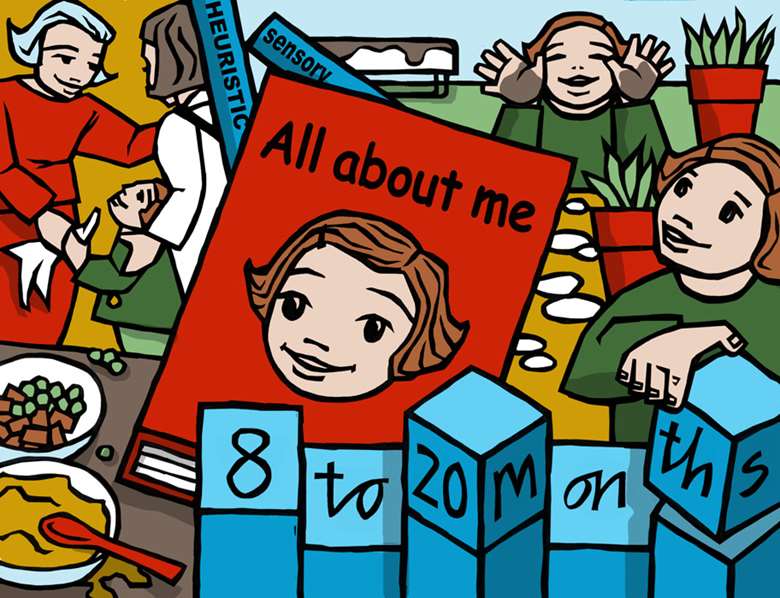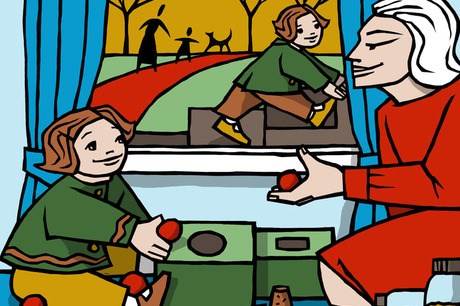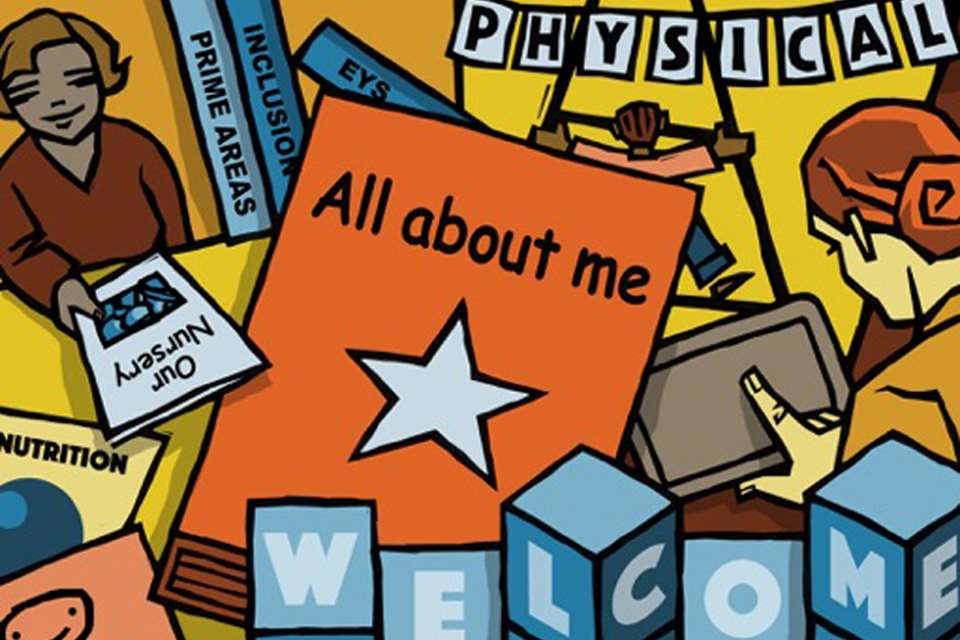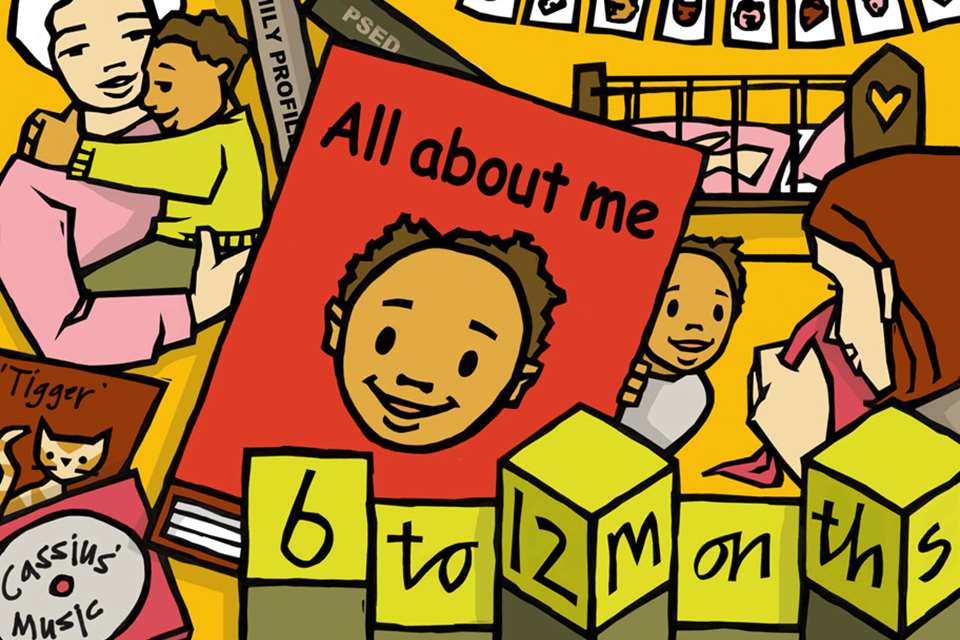STARTING POINTS: Part 3 - Adriana, 14 months
Julia Manning-Morton
Monday, March 7, 2016
Meeting the emotional and learning needs of the unique child

By Julia Manning-Morton, an independent consultant, trainer and author (www.key-times.co.uk/profiles/). She specialises in practice and provision that meets the needs of children under three and is an expert on the personal, social and emotional well-being of children and practitioners. Her publications include Two-Year-Olds In Early Years Settings: Journeys Of Discovery (2015) and Exploring Well-being in the Early Years (2014)
ADRIANA, 14 MONTHS
Fourteen-month-old Adriana lives in a flat on a new estate on the outskirts of a Norfolk village, with her 20-year-old mother, Ashley. Adriana is white European; her mother is English and has grown up and lived in the area all her life. Her father, Miguel, is Spanish, lives between England and Spain, and sees Adriana occasionally.
Her grandparents, Christine and Martin, live in the neighbouring village, and Ashley and Adriana spend a lot of time at their house, where Adriana enjoys the company of her young uncle and aunt, Ryan and Jenna.
Ashley is completing her training in hospitality and tourism. When she is at college or on placement, Adriana is looked after by her grandmother, now a registered childminder. Christine was happy to support Ashley and Adriana because she could see that, as a young and inexperienced mother, Ashley was struggling at times with parenthood. However, Ashley was keen to complete her training so she could provide well for Adriana in the future.
PHYSICAL DEVELOPMENT: ENVIRONMENTS
Adriana’s family’s homes are physical environments that she is familiar with and that impact on her growth, development and learning. For example, at home in the flat there is limited space to move around freely but at her grandparents’ house, there is a garden to explore and a small wood at the back of the house where they regularly take the dog for a walk.
These ‘walks’ are very short and very slow because Adriana has only recently started to walk unaided; using a typical wide gait, with her legs wide apart and arms out to keep her balance. She still often bumps down on to her bottom, either because she loses balance or because she chooses to revert to crawling in order to get somewhere more quickly.
The usual pattern of muscles developing strength from the head downward seemed to be slower than expected for Adriana. When she was 11 months old she was not sitting strongly and was not yet crawling.
Christine noticed that Ashley always chose to put Adriana in a lie-back chair rather than on the floor or on her lap. She realised that this came from Ashley’s lack of confidence in how to play with her baby and her great concern for Adriana’s safety.
Christine encouraged Ashley to go together to the health centre where they were running some parent and baby ‘development and play’ sessions. At these sessions, they learned more about how babies develop and the importance of ‘tummy time’ and unrestricted floor play and movement.
Ashley also met other parents and soon found that the difficulties that she experienced were shared by others. This boosted her confidence and she began to allow Adriana to lie on the rug at home and to enjoy playing ‘roly-poly’ games with her as they did in the group.
Very soon, Adriana was crawling and pulling herself up to stand, then walking by holding on to the furniture or to an adult’s hands. Her granddad in particular, liked to ‘walk’ her like this; even though Ashley and Christine kept telling him that it wasn’t necessary to rush this particular locomotor skill.
They explained to him what they had learned; that rolling, crawling and other movements helped Adriana’s brain to develop neural connections, to develop her balance and spatial awareness and to combine her sensory experiences with her thinking.
8-20 months: key aspects of gross motor development
Physical development is very rapid and varies widely at this age according to the individual child’s genetic inheritance, birth experience and socio-cultural experiences, but the general pattern of development will usually include these aspects:
l Pulling themselves to standing and holding on to furniture or a person for support
l Crawling, bottom shuffling or rolling to move around
l Walking around furniture (cruising) and by holding on to an adult’s hands
l Starting to walk alone, with feet wide apart and arms raised to maintain balance
l Moving to standing without help from furniture or people.
The Unique Child:
in practice
l After Ashley went back to college, Christine took up the advice from the ‘development and play’ sessions and put interesting things such as dried beans and glitter in clear plastic bottles that Adriana could crawl after as they rolled away
l Christine also crawled and rolled on the floor with her, under the dining table and through the chairs
l Adriana’s increased locomotor skills fuelled her curiosity in the world and when she started to want to go into the garden by herself, Christine taught her how to turn backwards in order to crawl down the back steps safely.
PHYSICAL DEVELOPMENT: USING TOOLS
Although her gross motor development had seemed a little slow, Adriana’s fine motor skills developed in line with usual expectations.
She played with her hands a lot when younger, bringing them together, watching and mouthing them. She now uses a pincer grasp and palmar grasp with confidence.
She likes to hold her bottle herself, moving it from hand to hand as she drinks, and to have her own spoon when eating, even though she can’t yet turn her wrist so the food often falls off the spoon; Adriana then picks the food up with her fingers and feeds herself.
The ability to pick up objects using the thumb and index finger – the pincer grasp – is crucial for fine manual tasks and is key to humans’ ability to use tools and to create. (Although the accomplishments of mouth and foot artists show how these skills can be developed in other parts of the body when use of the hands is limited).
8-20 months: key aspects of fine motor development
You will usually observe the following actions in babies in this age range:
l Passing toys from one hand to the other
l Holding an object in each hand and bringing them to the middle
l Picking up small objects between thumb and fingers
l Holding a crayon or similar tool in a palmar grasp
l Arranging a few toys either vertically or horizontally, that is, bricks or cars or toy animals
l Turning several pages of a book at once
l Showing a preference for one hand, but using either.
PHYSICAL AND COGNITIVE DEVELOPMENT: MEMORY, REPRESENTATION AND MAKING MARKS
Recently Christine noticed that Adriana was fascinated by the marks that appeared in her spilt custard when she moved her arm from side to side and trailed her fingers through it.
Adriana looked up at Christine to check her reaction. ‘Oooh sticky, let’s take a picture,’ said Christine in an interested tone and watched Adriana carry on, quickly taking a photo to show Ashley later.
The next day, Ashley laughed when Adriana repeated the same mark-making in her gravy, then looked at Ashley and then at her mobile phone, pointed and said ‘Pic’!
Here we can see Adriana integrating her physical movement and sensation with her capacity to remember events that have similar sensory experiences. She then used her fine motor ability to point, combined with her mental representations and understanding of the ‘camera/phone tool’ and what it does, in a social interaction using the shared symbol of the word picture/‘pic’. This shows just how amazingly complex and integrated her growth, development and learning are!
Piaget and the sensory-motor aspect of cognitive development
Babies build on the reflex actions they are born with through the active exploration of and interaction with their own bodies, people and objects around them.
As babies move, interact and play, they experience movement, sound, texture, light and pattern, tastes and smells. These sensory-motor experiences become mental concepts called schemes or schemas.
Piaget (1962) suggested that this happens through a process of ‘assimilation’; where a scheme takes in an event or experience and ‘accommodation’ where the scheme changes as a result of the new information. In this way the child adapts their thinking to the environment in order to maintain a state of equilibrium – that is, a mental state of balance in which the world makes sense.
These schemes are the basis of mental representations, the images of what things are in the mind, which help children and adults to hold onto, recall and think about things and people in their absence and to make new connections between similar images, objects, events and marks.
An important aspect of the ability to think is the ability to store, organise and retrieve information in memory. This can be seen in the way Adriana recalls her experience of being photographed in association with the sensory feeling of the food.
Adriana also shows her early abilities to understand symbols, through the way she regularly uses shared gestures – for example, always putting her hand to her mouth to ‘blow kisses’ when saying ‘good-bye’, just like the rest of her family do.
However, her understanding of symbols is still in the early stages of development, for example, she made Jenna laugh by trying to eat the (very realistic!) picture of a chocolate biscuit in a magazine.
Her rapidly growing cognitive skills can also be seen in the way she experiments with her toys and other objects, problem solving and exploring cause and effect.
Her granddad, Martin, said she spent half an hour in the paddling pool, trying to keep the plastic balls under the water; pushing them down and watching them bounce back up into the air then splash down again. And at the ‘stay and play’ sessions, Christine saw her trying valiantly to put the shapes into a (much too complicated) sorting box, eventually lifting the lid and putting them in, then tipping them out and starting again.
8-20 months: key aspects of cognitive and creative/respresentational development
l As memory develops, older babies can remember past events where there are sensory reminders
l They can imitate and recreate actions, sounds, gestures and moods after an event is finished, such as a funny face someone pulled, clapping or waving
l They can anticipate and predict the future, where there are regular routines, such as mealtimes, bath and bedtime.
l They have some understanding that things exist, even when out of sight; looking for dropped objects and searching for hidden items
l They often like to combine objects, gather objects together or put objects into containers
l They often have favourite stories, books, songs and rhymes
l They usually enjoy the sensory experience of making marks in food, sand, paste or paint, with hands, feet or tools held in a palmar grasp
l They use their whole body to explore and experiment with different materials and substances such as water and sand, and music.
The Unique Child:
in practice
l Christine set up small ‘heuristic play’ experiences in the living room (see Goldschmied and Jackson 2004)
l She put mud and water in a builder's tray in the garden for Adriana to make hand and foot prints and gathered twigs to make marks with
l She made her own sorting boxes out of tins and cut a round hole in the plastic lid of one and a square in the other. She also provided ping-pong balls, corks and small blocks that Adriana could more easily manipulate and post in order to give her a more satisfying and achievable experience of matching and sorting.
PERSONAL, SOCIAL AND EMOTIONAL DEVELOPMENT: ENVIRONMENTS
As we discussed in part two of this series (Nursery World 8-21 February), Bronfenbrenner’s Ecological Systems theory identifies aspects of the wider social systems — the physical and psychological environments – that impact on children’s development.
In this perspective, the locality that Adriana lives in and the services available there, are important factors. For example, there is little public transport in the area. This means that managing the journey from home to Christine’s to drop Adriana off in time to then get the bus to college, often puts Ashley under a lot of stress. In turn, it means she feels impatient with Adriana.
Adriana picks up on her mother’s frantic emotional state and then is often fractious and hard to settle when they arrive at Christine’s house, needing to hold on to her special blanket ‘bob’ for longer than usual.
Babies, toddlers and young children often seem to ‘catch’ other people’s emotions, crying when another baby cries, for example. These emotional reactions are the beginning of developing understanding of other people’s minds and empathy, which are fundamental social skills.
Even young toddlers show concern for their parents or siblings who are hurt or upset, although they will usually offer what would make them feel better. Only later will they offer what they know the other person finds comforting.
This ability to share emotions can also be seen in shared humour. For example, Adriana discovered that if she scrunches up her nose and snorts, it makes Jenna and Ryan laugh.
8-20 months: key aspects of development
l Older babies and young toddlers develop a range of ways to draw others into social interactions
l They build relationships with special people and are wary of unfamiliar people
l They respond differently to children and adults and are fascinated by older children.
l They share feelings with their trusted adults
l They rely on their trusted adults to provide a secure-base
l They often use a comfort object to soothe themselves, particularly when separated from their close adult
COMMUNICATION & LANGUAGE
As Adriana is developing her mental representations, she is also beginning to use the symbols of words to communicate.
She uses words that are useful to her such as ‘bot-bot’ for a drink of milk. She also shows how she understands language; when she dribbles the milk out of the bottle onto the table, she looks at Ashley, sees her frown and understands Ashley’s ‘No, thank you Adriana, no mess today.' Adriana shakes her head and says, ‘Uh-oh’.
Young toddlers’ understanding and expression are almost wholly non-verbal, using signs, gestures and their whole bodies to communicate their wants and needs and to understand other people.
These communications are most effective with people who they know well and who understand them well. For example, Adriana calls her comfort object ‘bob’, which confused the practitioner at the ‘stay and play’ session at first!
8-20 months: key aspects of development
Between these ages, older babies and young toddlers usually:
l watch and follow others’ body language intently, understanding their intentions and meaning in this way
l use pointing, eye gaze and gesture to make requests, and to share an interest
l understand single words in context, such as ‘dog’, ‘milk’, ‘daddy’
l use appropriate sounds when playing
l use single words, linking words to objects constantly
l experiment with sounds and words to communicate and imitate others.
FURTHER READING
- Goldschmied, E and Jackson, S (2004) 2nd Edition. People Under Three, Young Children in Day Care. Routledge.
- Gopnik, A Meltzoff, A and Kuhl, P (1999). How Babies Think. Weidenfield and Nicolson
- Manning-Morton, J and Thorp, M (2003). Key Times for Play: The First Three Years. OUP.
- Starting points, Part 2, www.nurseryworld.co.uk/nursery-world/feature/1155853/starting-points-part-2-cassius-8-months
- For information on the life and work of Urie Bronfenbrenner and Jean Piaget, visit: www.nurseryworld.co.uk/early-years-pioneers
- Pound, Linda (2005) How Children Learn: Educational Theories and Approaches - from Comenius the Father of Modern Education to Giants Such as Piaget, Vygotsky and Malaguzzi. Practical Pre-school Books
- For our series on the developing brain, visit: www.nurseryworld.co.uk/developing-brain and for more on schemas, visit: www.nurseryworld.co.uk/schemas






